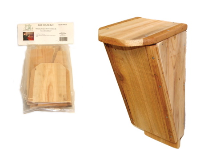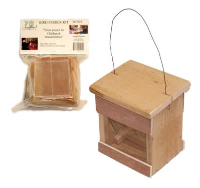-
Audubon Bird Field Guides Go Mobile
Nature at Bird Watchers’ Fingertips!
North American Guide to Birds app now available on iPhone and iPod Touch.
Woodstock, Vt. (Nov. 20, 2009) – The best-selling series of National Audubon Society bird field guide books have gone mobile, putting the most authoritative and comprehensive birding information at the fingertips of iPhone and iPod Touch users.
The Audubon Guide bird app provides a wealth of interactive information in a mobile package, giving bird lovers a fun and exciting experience that makes bird watching richer, more informed and instantly sharable. The bird app along with others in the Audubon Guides series is now available in the reference section of the apps store in iTunes.
“Mobile platforms allow field guides to be used to explore nature in fun and interactive ways that are not possible with printed books,” said Andrew Stewart, publisher of Green Mountain Digital, the electronic publishing company that created the Audubon Guide app series in alliance with the National Audubon Society. “Features like bird calls, GPS-location and the ability to share outings with family and friends are just a few finger taps away. These new apps transform field guides as we know them.”
From Chickadees to Condors, the Audubon Guide bird app covers more than 740 species of birds with information on appearance, habitat, behavior, diet, nesting, mating, migration, endangered status and more. Features include thousands of professional color photos, more than 2,200 bird sounds, and range maps for each species. Every species in the app is described with rich and detailed information updated from the book versions: all accessed wirelessly and in real time through elegant, interactive and intuitive search features. Search parameters include common and scientific names, family, shape, range, habitat, color, and size.
“This is a giant leap forward in connecting people with the nature that surrounds them,” said John Flicker, president of the National Audubon Society. “And it’s the first step in building a commitment to protecting the wonders this app will help a new generation discover and savor.”
The apps’ geo-location search features also allow users to find which bird species are located in any zip code, state or region. A universal dashboard enables navigation back and forth between species information, search functions, sightings, and more. When loaded onto a user’s iPhone, the apps work independently of cell phone connectivity.
Other innovative functions include the ability to create personalized life lists, post GPS-enabled bird sighting lists, and upload user-created photo albums.
The Audubon Guide bird app is supported by AudubonGuides.com, a free companion Web site that syncs with the app, providing a lifetime of automatic updates. The Web site features all of the comprehensive subject matter found on the app, as well as scientific news, user forums, articles and blog posts contributed by nationally recognized scientists and naturalists.
“The Web site really adds to the overall Audubon Guide user experience because it includes all of the information contained in the app as well as contributions by app users themselves,” said Stewart. “As people share their birding experiences on the site, we’ll see it becoming an increasingly useful tool in the research and cataloging of the natural world.”
The Audubon Guide bird app is now available in Apple’s iTunes store at the introductory price of $19.99. Three additional apps in the Audubon Guides series – Wildflowers, Trees and Mammals – are being offered at the introductory price of $9.99 each.
Birds, Wildflowers, Trees and Mammals will be followed in the next few months by mobile guides to Insects & Spiders, Butterflies, Fish, Reptiles & Amphibians, Seashells, Seashore Creatures, Mushrooms, Whales & Dolphins, and many other subjects. In this way, the Audubon Guide app series looks to deliver all of nature to consumers’ fingertips.
-
Wooden Birdhouse kits…for Bats, Feeders & Fun!
Birdhouse kits provide much more than the entertainment or project itself. With the serious decline in natural habitats due to urban sprawl and commercial zonings, nesting sites for wild birds are actually becoming scarce. It’s a tough real estate market out there!
As projects for church groups, schools, or a rainy day with your kids, there’s no better way to teach something about our precious environment and the immediate need for conservation efforts. Wooden birdhouse kits provide proper nesting sites for more than 50 species of cavity dwelling birds! The most common include: Bluebirds, Kestrels, Owls, Titmice, Chickadees, Nuthatches, Wrens, Tree Swallows, and Woodpeckers. While some other wooden kits include bat houses and bird feeders, there’s even a recycled plastic birdhouse and bird feeder kit now available.
-
Wild Horses and the Government’s BLM Pharse!
Lawsuit Filed to Halt Huge Wild Horse Roundup
Mass roundup of Nevada Wild Horses Inhumane and Illegal, Suit Charges
Washington, DC – In Defense of Animals (IDA) and ecologist Craig Downer today filed suit, in the federal U.S. District Court for the District of Columbia, to stop the Bureau of Land Management’s proposed massive roundup and removal of more than 2,700 wild horses from public lands in Nevada. The roundup, slated to begin in early December, will take virtually every wild horse living in the Calico Complex Herd Management Area in northwestern Nevada. It is by far the largest of any wild horse roundup planned by the BLM for Fiscal Year 2010.“This suit aims to halt the inherent cruelty of the BLM’s wild horse roundups, which traumatize, injure and kill horses, subvert the will of Congress and are entirely illegal,” said William Spriggs, Esq., a partner at Buchanan, Ingersoll & Rooney and lead counsel on the law suit. The firm is representing IDA and Mr. Downer on a pro bono basis.
The suit alleges that the BLM plan to utilize helicopters to indiscriminately chase as many as 2,738 of the estimated 3,095 Calico horses into holding pens violates the Wild Free Roaming Horse and Burro Act, passed unanimously in 1971. The Act designated America’s wild horses and burros as “living symbols of the historic and pioneer spirit of the West,” specifying they “shall be protected from capture, branding, harassment, or death … [and that] to accomplish this they are to be considered in the area where presently found, as an integral part of the natural system of public lands.”
“Americans strongly support protecting wild horses on their natural ranges in the West.” Mr. Spriggs continued. “We hope to stop the cruel roundups and mass stockpiling of wild horses and burros in government holding facilities while the Obama Administration crafts a new policy that protects these animals and upholds the will of Congress and the public’s desire to preserve this important part of our national heritage.”Since 1971, the BLM has removed over 270,000 horses from their Western home ranges and taken away nearly 20 million acres of wild horse habitat on public lands that were protected by Congress as being “necessary to sustain an existing herd or herds of wild horses and burros … and … is devoted principally … to their welfare.” The policy is based on the unsupportable claim that Western ranges cannot sustain wild horses and burros. These animals comprise a tiny fraction of animals grazing the range. An estimated 8 million livestock, but only 37,000 horses and burros, graze on public lands.
Thirty-two thousand wild horses who have been removed from the range are already held in government holding facilities, and the BLM intends to round up 12,000 more horses in FY 2010.


